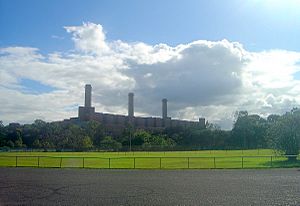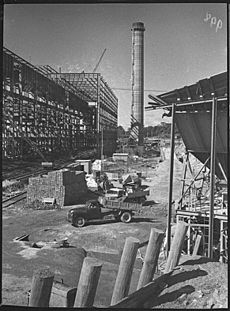Wangi Power Station facts for kids
Quick facts for kids Wangi Power Station |
|
|---|---|

Wangi Wangi Power Station, 2007
|
|
| Location | Wangi Wangi, City of Lake Macquarie, New South Wales, Australia |
| Built | 1949–1960 |
| Architect | Railways NSW architect (unknown) & Colin Smith of CH Smith & Johnson Architects |
| Owner | Centennial Fassifern Pty Ltd; Department of Trade & Investment, Regional Infrastructure & Services; IJ McDonald Pty Ltd; National Parks and Wildlife Service |
| Official name: Wangi Power Station Complex | |
| Type | state heritage (built) |
| Designated | 2 April 1999 |
| Reference no. | 1014 |
| Type | Electricity Generator/Power Station - coal/gas/oil |
| Category | Utilities - Electricity |
| Builders | several |
| Lua error in Module:Location_map at line 420: attempt to index field 'wikibase' (a nil value). | |
The Wangi Power Station is an old coal-fired power station in Wangi Wangi. It sits right on the edge of Lake Macquarie. This power station worked from 1956 to 1986. It was very important for supplying electricity to the state of New South Wales. For a while, it was even the biggest power station in the state! This large building, about 12,000 square metres in size, was added to the New South Wales State Heritage Register on April 2, 1999. This means it's a special place protected for its history.
History of Wangi Power Station
In 1946, the government of New South Wales decided to build this power station. It was built by the New South Wales Government Railways. Wangi Wangi was chosen because it was close to a big lake for water and also near coal mines.
The power station officially opened on November 7, 1958. The Premier of NSW, Joseph Cahill, was there. It took ten years to build. For two years before the official opening, different parts of the station were slowly turned on. Six large machines called "turbo-alternators" were installed. These machines helped make electricity. At its busiest, about a thousand workers lived in Wangi Wangi during the construction.
The Wangi Power Station was very important in the late 1950s. It helped stop serious power shortages and blackouts in New South Wales. It also played a big role in getting power back after a huge state-wide power shutdown on June 10, 1964.
The power station stopped working in 1986. This was about 30 years after it first started making electricity. Most of the equipment that made power was taken out by the early 1990s. Even though the machines are gone, the main buildings and tall chimneys are still standing today. Since the 1990s, there have been ideas to turn the site into homes and shops.
How Wangi Power Station Generated Power
The Wangi Power Station had two main sections, often called 'A' Station and 'B' Station. They worked a bit differently to make electricity.
'A' Station: Early Power Generation
The 'A' Station had three large machines that made electricity, each producing 50 megawatts (MW) of power. These machines were powered by steam. The steam came from six boilers that burned coal. Coal was thrown onto a special grate, and much of it would catch fire before even landing. This system helped control how much coal was burned.
'B' Station: Later Power Generation
The 'B' Station was built later and had three even bigger machines, each making 60 MW of power. These machines also used steam. But instead of burning coal on a grate, these boilers burned coal that had been ground into a fine powder. This made the burning process more efficient.
Reducing Pollution from the Station
To help keep the air cleaner, special equipment was added in 1976. The 'A' Station got "shaker-type fabric filters." The 'B' Station got "high pressure pulse jet bag filters." These filters worked like big vacuum cleaners. They caught tiny dust particles and ash from the smoke before it went out the chimneys. This helped reduce visible pollution. These types of filters later became common in other power stations in New South Wales.
Why Wangi Power Station is a Heritage Site
The Wangi Power Station is very important to the history of New South Wales. It's considered a "heritage-listed" site because of its special past.
Leading Power Generation in NSW
This power station was a leader in how electricity was made in New South Wales. It showed how power stations could be built near coal mines. For its first five years, it was the largest power station in the state. It played a huge part in stopping power shortages and blackouts in the late 1950s. It also helped get power back on after a big state-wide shutdown in 1964. Wangi Power Station was the last one built by the Railways and the last one to close. It shows the change from the Railways to a new group, Elcom, as the main power provider in NSW.
Unique Design and Architecture
The Wangi Power Station is also special because of its beautiful design. It was meant to be a "showpiece" for power generation. This means it was built to look good, not just to work well. The building has excellent design, high-quality brickwork, and looks outstanding. It's rare to find an industrial building from that time that was designed so carefully to fit into its surroundings.
Important Construction Methods
The way Wangi Power Station was built was also unique. It's one of the last big buildings in Australia to use a construction method called "riveted steel" for its frame. Also, it used an early form of "fast tracking." This meant one part of the building was already making electricity while another part was still being built!


